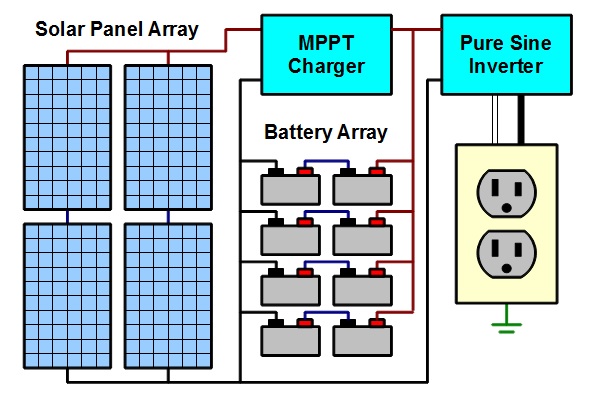
|
|||
|
Solar Design Guide
We've written this online guide and online calculators to help the off-grid enthusiast make better purchasing and system design decisions. First, some definitions are in order. Grid-Connected or Off-Grid?
There are two major types of solar installations, grid-connected or off-grid. The differences between these two installations are as follows: Grid-Connected
Sometimes also called grid-tied, a grid-connected system integrates your solar panels into the world at large. This is usually done to offset electrical costs, and the driving factor for such an installation is often financial. Such a system will use special inverters and switches which can allow energy to flow into or out of your home or business, depending on whether the solar array is producing power or not. Very rarely will such a system include batteries to store the energy for use at night. This kind of system can be thought of as an extension of the power company, rather than a self-sufficient energy source. If your interest is in grid-connected systems, that is beyond the scope of the material on our website. Off-Grid
An off-grid system, on the other hand, is primarily intended to provide power completely independent of the larger power grid. An off-grid system features large battery arrays to supply continous power, even at night, and chargers to store energy in these batteries during the day. For the same amount of daily energy production, an off-grid system will be more expensive than a grid-tied system, but will supply power regardless of the condition of the power grid. This design guide will help you make good decisions affecting your off-grid system, and cut through a lot of the misleading information floating around about online ads you will see for solar "systems" that won't actually deliver what they promise. Defining the Required Continuous Power
Before making a purchasing decision, you must first determine your requirements for continuous use. This is where most solar ads are misleading: a 100 watt (100 W) solar panel "system" will NOT supply 100W of useful continuous power. The best continuous load you could expect to drive from this panel, day in and day out, would be 20W, and this only if you designed the rest of the system correctly. In this design guide, we consider four different power levels, 50 W, 100 W, 250 W and 500 W, and six system designs which will supply this need on a 24/7 continuous basis (except during a stretch of very bad weather, which will degrade operation somewhat). These power levels can typically fulfill the following needs:
Note that typical residential energy use will be in the 2500 to 4000 kWhr range per month, resulting in 3500 W to 4500 W continuous if that were evenly distributed throughout the day (divide your monthly kWhr usage by 720 to know for sure), but more likely with peaks of 10,000 W or more. Clearly, the kind of systems we are talking about here will not even come close to a complete off-grid existence without seriously impacting your quality of life. Components of Any Solar System
Once you have decided what continuous power you need, it is time to select components to fill that need. Any off-grid solar system needs the following components: • Deep-cycle batteries, sized to hold approximately twice the power you will need during each day. These will be arranged in a multi-battery array. • Solar panels, approximately five- to six-times the label capacity as the continuous power your system needs to deliver, arranged in an array of panels. • A Maximum Power Point Tracking (MPPT) charger, to charge your batteries fully during the solar day. • An off-grid inverter (pure sine wave if motors are used), to convert the battery power to useful AC. • Safety components. • Cables and connectors to tie it all together. • Cable selection, each leg of wiring in your system has different needs. A typical high-level arrangement of these components is shown below: 
All these components must be considered together in order to design a system capable of making the most of your investment. It is also our goal to help you design systems that have upgrade paths which efficiently use parts from smaller systems. Read about each of these component classes in the following sections. Our Battery and Solar Array Calculators
If you are already familiar with selecting solar components, skip ahead to our handy Battery Array Calculator and Solar Array Calculator to help with the math and let you focus on design decisions. Next article: Selecting deep-cycle batteries ... |
Announcements
Amateur Radio Solutions Available Our development staff now includes Amateur Extra radio FCC licensees, increasing the breadth of our existing wireless development services. Posted: 12 Nov 2015 Details Here |
|||||||||||
© 2001 - 2016 SoftBaugh, Inc. All rights reserved.